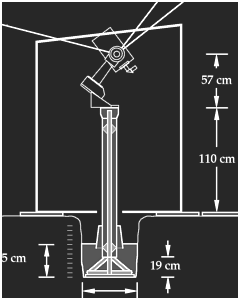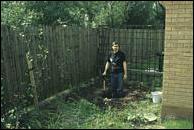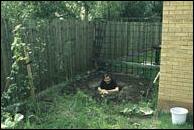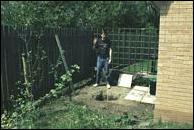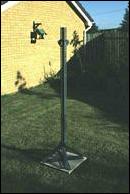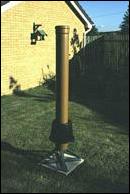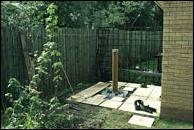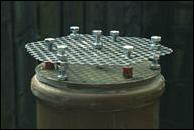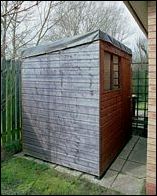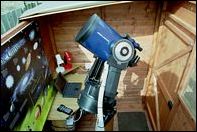|
|
||
|
Phase I: A hole was dug where the telescope pier was to be sited. This was behind my garage, which served to block local street lighting. As the garage is to the north of the observatory, it does not block any interesting part of the sky. |
||
|
|
||
|
The hole ended up about 60 x 60 x 60 cm, which was a compromise between stability of the pier and the amount of concrete required. |
||
|
|
||
|
Phase II: Paving slabs were laid around the hole to support the shed. Keeping the pier separate from the foundations of the shed ensures that movements of the shed do not get transmitted to the pier and the telescope. |
||
|
|
||
|
Phase III: A skeleton for the telescope pier was built using angle-iron and bolted to a paving slab. This skeleton construction acted as reinforcing for the concrete pier and also made it easier to position the pier in the hole dug for it. |
||
|
|
||
|
A sewer pipe (2 m long, 150 mm diameter) formed the outer surface of the pier. About one third of the pier will be below ground level to put the telescope at a comfortable viewing height. |
||
|
|
||
|
Phase IV: The skeleton and pipe were placed in the hole and concrete poured to a level of 30 cm above the bottom of the hole. The next day, the pipe was filled with concrete. A total of 375 kg of concrete was used. |
||
|
|
||
|
To keep the aggregate in the concrete away from the positions where bolts would be used to attach the telescope mounting, a temporary contraption was constructed to suspend three plastic pens in the setting concrete.
|
||
|
|
||
|
Phase V: Once the pier was complete, a standard 7' x 5' shed had a circular hole cut into the centre of the floor using a jigsaw and was dropped over the pier. The roof was replaced with three hinged panels to allow different parts of the sky to be seen by the telescope. A weatherproof cover keeps the elements at bay when the observatory is not in use. |
||
|
|
|
|
|
Finally, the Meade LX-50 Schmidt-Cassegrain telescope was bolted to the pier. The picture shows the view looking into the observatory with two of the three roof panels hinged back. The laptop Mac is used to acquire images from a CCD camera (not shown) and the small handset on the table controls the telescope drive motors. |
||
|
|
|
|
|
Steve Barrett February 2003 |
|
|
